How many American ships sunk kamikazes?
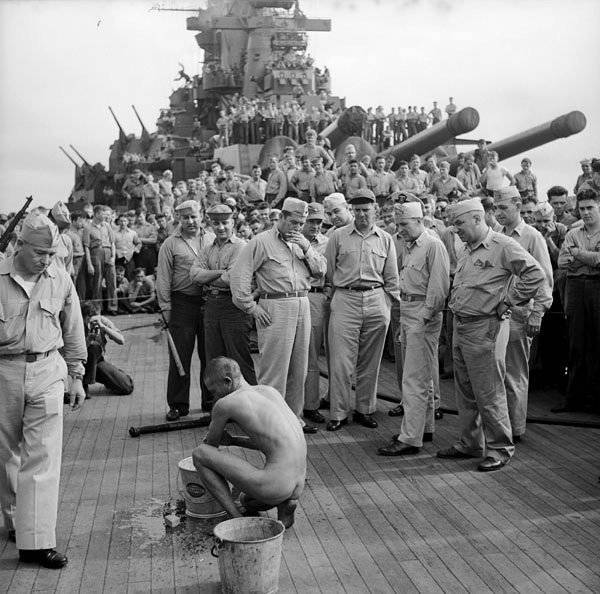
8 April 1942 in the sky over Murmansk was a hot air battle. Lieutenant Alexei Khlobystov rushed to the twin-engine Me-110 and boldly “poked” with his wing of his Kittyhoek. A sharp jerk to the right, a terrible crash ... Alexey mechanically leveled the car and carefully looked at the wing - the right plane was decently stripped. "Messer" disappeared somewhere. Experiencing the German fighters did not give a feeling of joy - in the ensuing "carousel" Alexey contrived and damaged the right wing "cut off" the tail of another Messerschmitt. This time it was harder - a blow tore off half the plane. Only due to the exceptional courage and skill of the pilot, the Kittyhawk was able to return to the Murmashi airfield. Well, also because it was durable, an infection ...

Suicide attacks were practiced in all countries without exception. Each army had its own Gastello and Matrosov, who threw their breasts at the embrasures of the machine guns and fell on the head of the enemy with a fiery meteorite. Someone was lucky - such as Alexei Khlobystov, who in his short life made 3 successful air ramming (but accidentally died, colliding with his follower in the air). Someone, being in a hopeless situation, desperately rushed at the enemy, gritting his teeth with hatred - knowing that he was seeing the sky and the earth for the last time. But to all the vicissitudes in spite of, people loved life and did not want to die! Life made a choice for them.
But only in Japan, the suicide attacks from the latest decisions of the heroes in an extreme situation, turned into popular entertainment with special rituals and theatrical performances. Kamikaze “sentenced” himself to death in advance, life lost all meaning for fanatics, the main thing is to die beautifully in battle. Having much admired themselves, they, waving their swords, got into the cockpits of the planes (as an option - into the cabins of the guided torpedoes - “kaitans”) and rushed towards the enemy.
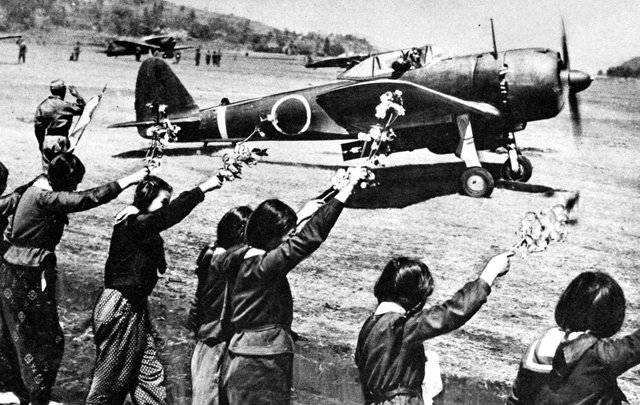
There is an opinion that kamikazes are untrained youngsters on decrepit Zero fighters with a developed resource. This is not quite so - for the suicide attacks, the Japanese used everything that could fly: the Zero, Oscar, Abdul, and Nick fighters; bombers "Val", "Kate", "Judy", reconnaissance "Gekko" and "Babs"; float seaplanes "Jake", "Floor", "Elf" ... New and old, sea-based and land-based, combat and training, with or without bombs. Even a specific means was created for the kamikaze - the Oka jet-projectile suspended from the carrier's fuselage, the GetNXXM Betty bomber. Cruel weapon. Although clumsy - a bunch of two aircraft was a tasty target for American fighters. Well, in a desperate desire to stop the enemy's fleet, all means were good (or rather, bad).
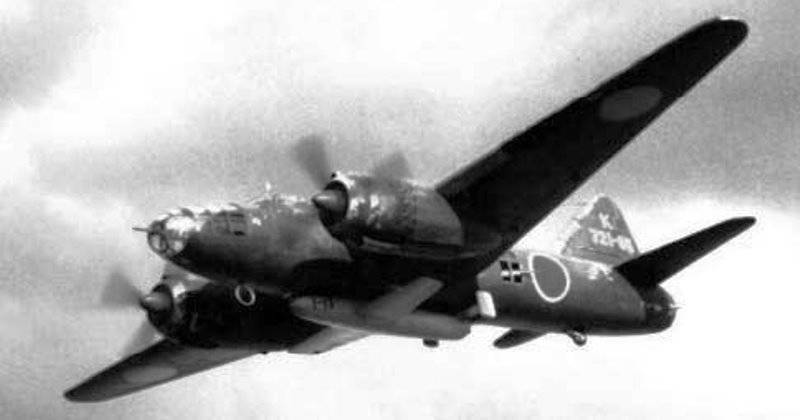
As the statistics show, two thirds of the kamikazes were shot down by air patrols and automated anti-aircraft guns or disappeared without a trace in the expanses of the Great Ocean. And from those who are still “lucky” to crash on the decks of enemy ships, the damage was not as much as the Japanese command had hoped. Especially considering the scale of suicide attacks - Japanese pilots 3913 became the “divine wind” (excluding naval pilots, who independently decided to crash on board the ship).
Kamikaze managed to sink several dozen ships and vessels, with a total displacement of the order of 150 thousand tons.
For comparison, the submarines under Otto Krechmer’s command sank 40 ships - 208 thsd. 208 warship, one vehicle was captured and around 2 damaged. The German ace himself survived the war and crashed into a car in 400.
Among the sunk kamikaze ships there is not a single large artillery or aircraft carrier ship. All the victims - destroyers, boats, auxiliary ships and four escort aircraft carrier. The exact number of destroyed is still unknown - in open sources and registers you can find information on any ship of the US Navy, another thing is that there is no clear classification of damaged, sunk or non-recoverable ships.
For example, the escort destroyer Oberrender (USS Oberrender, operational code DE-344) was damaged by a kamikaze 9 in May 1945 of the year (what a date!), But got to the coast. Not recovered, was sunk as a target in November 1945.
Another example is the destroyer Hutchins (USS Hutchins, operational code DD-476). Damaged by a kamikaze boat near Okinawa. There are no casualties, the destroyer was able to return to Portland on July 15 1945. Not recovered, was scrapped in 1948 year.
What caused the refusal to restore the Hutchins and Oberreder: too much damage, or a global reduction fleet after the war?
If serious damage was to blame, then why, for example, was the destroyer Laffy destroyed from nose to stern (USS Laffey (DD-724), into which six kamikazes crashed?
In order to further exclude the manipulation of facts, I propose the following scheme - that the ship, which after the fateful campaign has never been used as a ship (even if it did not sink immediately and was able to return to the base), was considered destroyed. In accordance with this logic, I was able to reliably establish 64 death case American ships and ships from the actions of the kamikaze pilots (the names of the ships, their operational code, photographic materials, a brief story deaths, date and coordinates of the place of flooding). There are probably a dozen unaccounted cases hidden in the archives - as a result, their number may exceed seven dozen ... although this already has little value. It is foolish to count boats and barges, if only because their cost is less than that of an airplane.
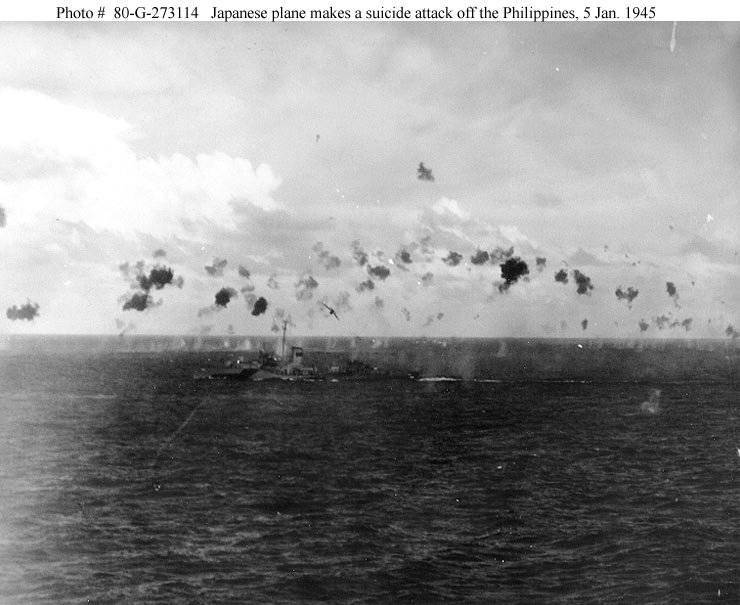
We go further:
On the account of the man-torpedoes "Kaiten" three trophies - tanker "Missinev", landing craft and escort destroyer "Underhill". Using the "Kayten" the Japanese ultimately hurt themselves - the submarine with the "Kaytenami" attached to the hull was especially vulnerable at the time of preparation for launching man-torpedoes. As a result, the Japanese lost eight submarines, another 15 man died during the testing of the “miracle weapon”.
Another 7 American ships destroyed the speed boats, controlled by suicide bombers - one destroyer (the same “Hutchins”), a boat-hunter and five landing barges. And this is despite the fact that 400 kamikaze boats loaded with explosives were preparing for attacks in Okinawa!

Finally, the most mystical part of the Kamikadze project is suicide swimmers. With an 9-kg ballast mounted on their backs and two compressed-air cylinders, these geeks had to go down to the American ships in shallow water and undermine them with an 15-kilogram bomb tied to a long bamboo pole. The official result of all efforts is the damaged landing craft LCI-404.
In total, as a result of kamikaze attacks (airplanes, man-torpedoes, speedboats), the 74 of the American ship was destroyed. Considered ships of the Navy, the Coast Guard and the US Army. In short, this story looks like this:
- 4 escort aircraft carrier - "Saint-Lo", "Ommani Bay", "Sengamon" and "Bismarck Sea". Especially hard to die "Bismarck Sy", whose crew lost 300 people killed. On Saint-Lo and Ommani Bay there were fewer dead - 113 and 95 people, respectively.
But especially the delusional story happened to the Sengamon escort aircraft carrier: in May, a single kamikaze crashed into 1945. A large fire center appeared on the flight deck, three dozen seamen were killed. To help the aircraft carrier rushed one of the escort destroyers - but it would be better if he did not. The aircraft carrier turned awkwardly - and with the edge of the flight deck carried the destroyer to the entire superstructure. All would be okay, but at that time the sailors in panic began to push the burning aircraft into the sea - one of them crashed right onto the deck of the unfortunate destroyer. On the destroyer something exploded - as a result, both ships received severe damage. “Sengamon” managed to reach the shore, but was excluded from the lists immediately after the war - in October 1945.
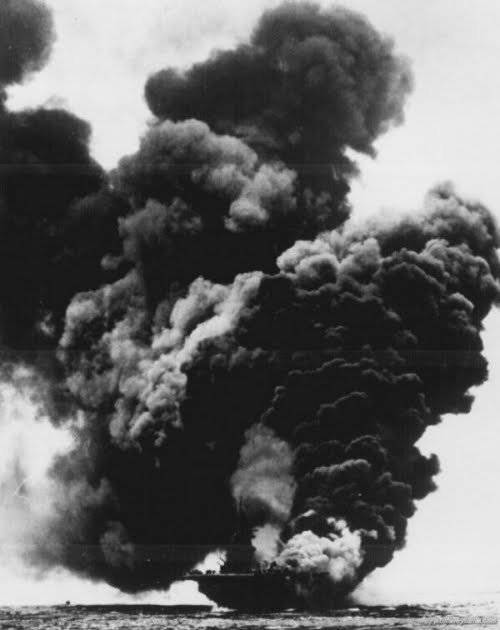
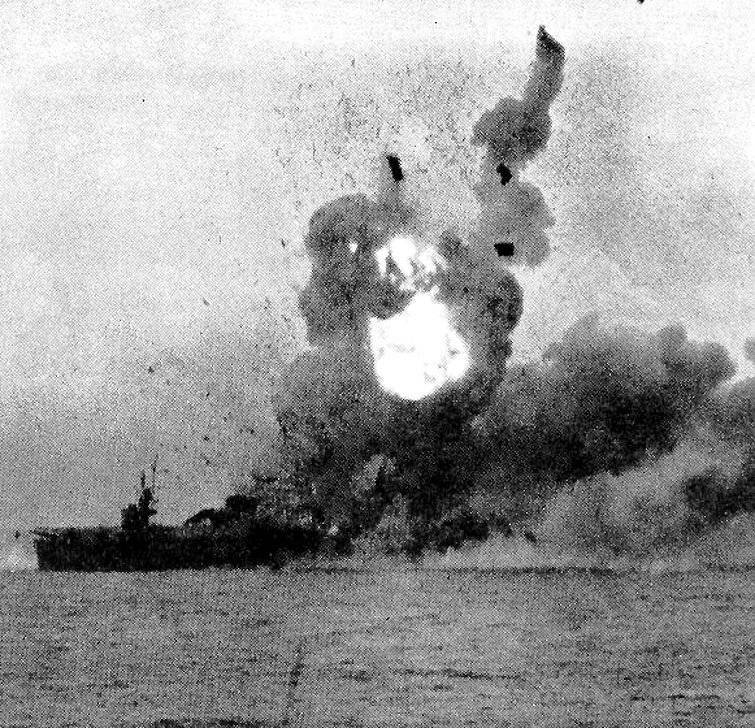
- 26 destroyers of various types. Such a large number of killed destroyers is explained by the fact that they often performed the tasks of the radar patrol in the most dangerous directions, and the fury of the Japanese pilots in the first place fell upon them.
Actually this ends the list of worthy victories. All other trophies look like a mock kamikaze. Six special transports of the US Navy (converted from obsolete 20's destroyers), twenty landing ships, three small fire support ships, a torpedo boat, two ammunition vehicles, three hunter boats, two tankers, a hospital ship and a floating dock!
By the way, not all of them are honest kamikaze prey - for example, the tank landing ship LST-808 was first damaged by the Japanese aviation, lost the course, and only then was finished off by a suicide ram.
Another great victory of the kamikaze is the Soviet minesweeper KT-152, which is also the former fishing boat Neptune with a tonnage of 62. It was sunk by a ram of a twin-engined Japanese fighter in the area of the Kuril chain 18 in August 1945.
26 destroyed destroyers - is it a lot or a little? On the one hand, it is more than the number of destroyers in the Northern Fleet throughout the Great Patriotic War. On the other hand, in April, a squadron from 1945-1200 (according to various sources) of the Allied ships operated on Okinawa on the island of Okinawa ... kamikazes could dive with their eyes closed - it was simply impossible to miss.
The destructive power of the kamikaze plane was clearly not enoughto sink a large warship. Therefore, most of the victims of the Japanese suicide attacks were “only” damaged. The number of damaged ships, according to various estimates, varies between 200 - 300 units, the Americans themselves recognize 288 ships and ships damaged by kamikaze strikes.

The law of Gauss helps in assessing the scale of losses - most of the injured suffered "moderate severity" - the deck was broken, a number of mechanisms were put out of operation, two or three dozen injured crew members.
A smaller part of the ships, sometimes for quite objective reasons, suffered extremely heavy air suicide attacks - for example, in the battle for the Philippines the 22 of the aircraft carrier was damaged. On Franklin, the 33 of the aircraft and the 56 of the sailors burned in flames. The damage to Bello Wood turned out to be just as strong - about a hundred people died on this aircraft carrier! But a particularly dangerous fate was awaited by the heavy aircraft carrier Bunker Hill during the Okinawa battle: as a result of a double attack, the kamikaze lost all of the wing (80 planes) and almost the crew member 400!
British aircraft carriers Indomiteble, Victories and Formidable were also subjected to suicide ramming. This was more fortunate: the kamikazes, like nuts, cracked about their thick flight armor, without causing harm to the inside of the ship. The Australians also got it - their flagship cruiser “Australia” was attacked by madmen six times, alas, without much success.
Finally, rare lucky ones - ships whose damage, for various reasons, was limited to cosmetic defects and stripped paint. For example - the battleship "Missouri", for which the suicide bogie was only a funny incident without human victims and destruction.
Although even highly protected battleships were not insured against accidents: on New Mexico, the kamikaze destroyed the superstructure in the chimney area, as a result, the ammunition from nearby anti-aircraft guns was in the engine room, 55 people died. On the battleship “Maryland,” a kamikaze destroyed the forecastle side, having destroyed the 89-mm armored deck, exploded all the hatches and doors in this part of the ship, 31 died in the fight against fires.
And yet, despite the enormous damage caused to the American fleet, the effectiveness of kamikaze tactics was, to put it mildly, controversial. Purely from a military point of view: destroying 30 ships of the third rank (destroyers and escort ships) and causing more or less serious damage to 150 ships (half of the total number of damaged ones) instead of losing 3913 pilots and about 2500-3000 aircraft (not counting downed G4M - jet carriers Oka aircrafts, speedboats, Kaiten man-torpedoes and submarines killed because of them) look dim and uninteresting against the background of the success of German submariners or 30 bombers of Captain McCluskey, who burned three s Japanese aircraft carriers at Midway.
On a strategic scale, the successes of the kamikazes are fading away altogether: the loss of four escort aircraft carriers had no effect on the combat capability of the US Navy — the Americans had 130 of such ships.
26 destroyers destroyed by kamikaze? For comparison: over the years of the war, the US Navy lost the 81 destroyer, but were not upset about it at all - they had five hundred in stock.
Did the American steel armadas never notice the brave Japanese guys? Noticed. The appearance of suicide pilots led to changes in the organization of the fleet's combat service: radar patrols appeared, the composition of aircraft carrier aircraft groups (3 / 4 fighters) changed, work began on the creation of a ship-based anti-aircraft missile system.
Reflecting and preventing suicide attacks (echeloned air patrols, strikes at enemy airfields) took a lot of time and effort, the kamikaze’s actions distracted sailors from the main fire support tasks and depressed the crew’s psyche - it’s still unpleasant to have an enemy who is not afraid of death in principle .
Epilogue. For me, the feat of non-commissioned officer Sakio Kamatsu, which he accomplished on 19 on June 1944 of the year, is much brighter and more tragic. His Zero took off from the deck of Taiho just at the moment when the US Navy submarine Elbakor launched 6 torpedoes on a heavy Japanese aircraft carrier with a fan. Seeing the deadly foamy trail in the direction of his ship, Sakio Komatsu took the right decision in an instant - the Zero rushed down and disappeared into a cloud of spray, taking the trouble away from the aircraft carrier.
Sakio Komatsu did not wear a “hachimaki” bandage on his head, he did not drink the ritual bowl of sake before departure, and he was not escorted by a schoolgirl with sakura branches. But in an extreme situation, this man, without the slightest hesitation, sacrificed his own life for the sake of his Motherland. Is this not a real feat?

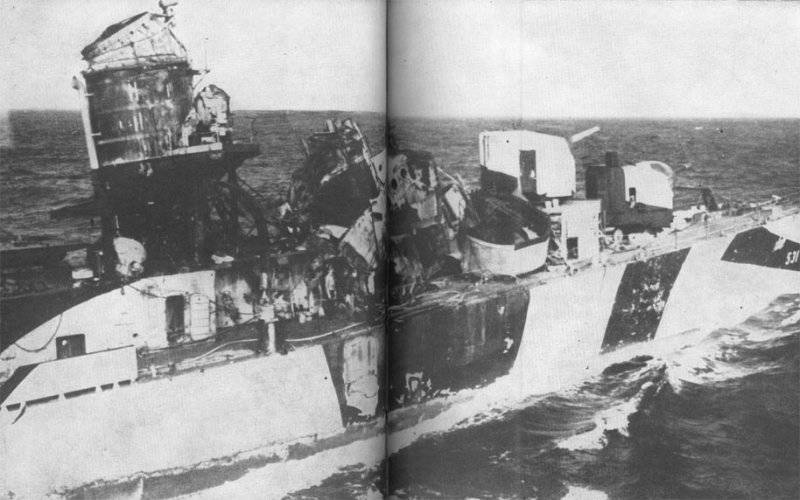
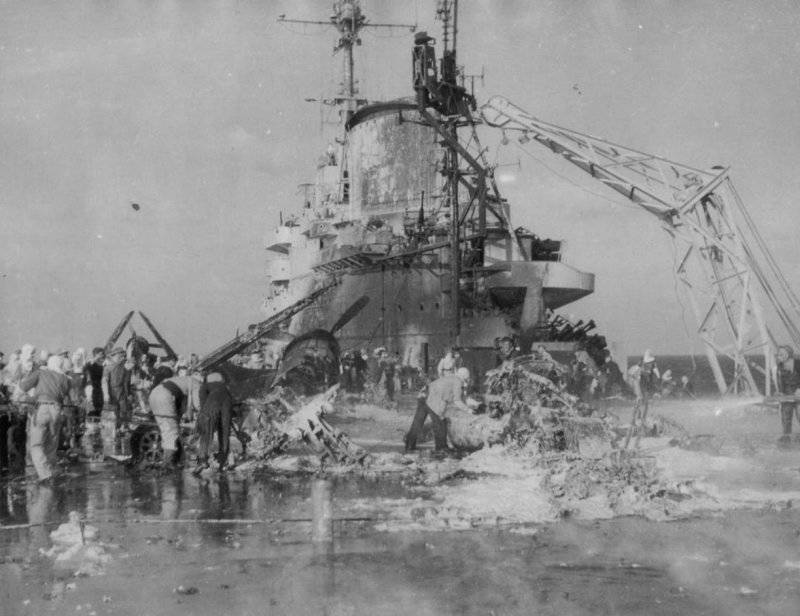
Information